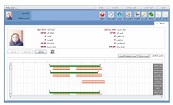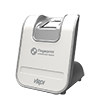Attendance systems, particularly attendance devices and access control solutions, have revolutionized how organizations monitor employee presence and manage workflows. These technologies streamline operations, improve productivity, and reduce administrative burdens, ensuring a significant return on investment for businesses.
This comprehensive article delves into the pivotal role of attendance systems, exploring their features, benefits, and impact on organizational efficiency, while addressing key challenges and trends.
Types of Attendance Systems
An attendance system is a technological tool designed to record, track, and manage employee working hours. These systems eliminate manual errors and enhance transparency in organizations.
- Biometric Systems: Utilize unique biological traits like fingerprints or facial patterns.
- Card-Based Systems: Employees swipe or scan ID cards to record their attendance.
- Cloud-Based Systems: Allow remote access and integration with multiple branches.
- Mobile Attendance Apps: Enable attendance tracking through smartphones.
Key Features of Attendance Devices
Modern attendance devices offer advanced features to cater to diverse organizational needs:
- Biometric Authentication: Fingerprint, face recognition, or iris scanning for secure verification.
- Access Control Integration: Restrict entry to authorized personnel.
- Cloud Connectivity: Real-time data access and remote monitoring.
- Customizable Reports: Generate detailed attendance and payroll reports.
- User-Friendly Interfaces: Easy-to-use designs, ensuring a smooth user experience.
Benefits of Attendance Systems
Improved Productivity
Attendance systems reduce time spent on manual record-keeping, allowing HR teams to focus on strategic initiatives.
- Real-time tracking ensures that employees adhere to schedules.
- Automated processes minimize administrative workloads.
2. Enhanced Accuracy
Manual systems are prone to errors, but attendance devices eliminate discrepancies by accurately recording data.
- Biometric devices prevent proxy attendance.
- Automated systems ensure reliable time logs.
3. Better Compliance
Many organizations face legal requirements to maintain accurate attendance records.
- Attendance systems simplify compliance with labor laws and regulations.
- Detailed records serve as evidence in disputes or audits.
4. Cost Efficiency
Though the initial investment in attendance systems may be high, they lead to long-term savings by reducing:
- Payroll errors
- Overtime disputes
- Administrative overheads.
5. Increased Employee Accountability
Attendance devices foster a culture of punctuality and discipline by tracking entry and exit times.
The Role of Access Control in Organizational Efficiency
Access control systems work hand-in-hand with attendance systems, offering:
- Enhanced Security: Restrict unauthorized access to sensitive areas.
- Integration: Combine attendance tracking with security management.
- Visitor Management: Monitor non-employee entries in real time.
How Attendance Systems Improve Organizational Workflow
1. Automating Timekeeping
Traditional time-tracking methods are labor-intensive and error-prone. Attendance systems automate these tasks, ensuring accuracy and efficiency.
2. Streamlining Payroll Processing
Integrated attendance and payroll systems automatically calculate work hours, overtime, and leave balances.
- Reduces payroll errors.
- Saves time for HR teams.
3. Enhancing Remote Workforce Management
Cloud-based attendance systems and mobile apps cater to remote and hybrid work models.
- GPS tracking ensures employees mark attendance from designated locations.
- Flexible systems accommodate varying schedules and time zones.
4. Facilitating Data-Driven Decisions
Attendance data provides insights into workforce trends:
- Identify high-performing employees.
- Address absenteeism or late arrivals.
- Optimize shift scheduling.
Challenges in Implementing Attendance Systems
1. High Initial Costs
Advanced biometric systems may require significant upfront investment, posing challenges for smaller businesses.
2. Privacy Concerns
Collecting biometric data can raise employee concerns regarding data security. Organizations must comply with data protection regulations like GDPR.
3. Resistance to Change
Employees accustomed to manual systems may resist transitioning to automated solutions.
4. Environmental Dependencies
Biometric systems may face challenges in extreme conditions:
- Dust or moisture affecting fingerprint scanners.
- Poor lighting impacting face recognition devices.
Trends in Attendance and Access Control
1. AI-Powered Systems
Artificial Intelligence enhances biometric accuracy, enabling faster and more secure attendance tracking.
2. IoT Integration
Attendance systems connected to the Internet of Things (IoT) offer seamless integration with other workplace technologies.
3. Multi-Factor Authentication
Combining biometrics with PINs or smart cards increases security.
4. Cloud-Based Solutions
Real-time data access, scalability, and cost-effectiveness drive the adoption of cloud-based systems.
Selecting the Right Attendance System for Your Organization
Choosing the right attendance system depends on several factors:
- Organization Size: Larger businesses may require scalable solutions.
- Security Needs: High-security industries benefit from biometric and multi-factor systems.
- Budget: Balance between cost and features to ensure ROI.
Case Studies: Success Stories
Case 1: Manufacturing Industry
A manufacturing firm with over 500 employees adopted a fingerprint-based attendance system. The result:
- Reduced payroll errors by 30%.
- Improved punctuality across shifts.
Case 2: IT Company
An IT company implemented a cloud-based attendance and access control solution. Key outcomes:
- Streamlined remote workforce management.
- Enhanced data security through multi-factor authentication.
Conclusion
Attendance systems and access control devices play a vital role in improving organizational efficiency. They reduce manual workloads, enhance security, and foster accountability among employees. As technology evolves, adopting modern, scalable solutions becomes imperative for organizations to stay competitive.
By investing in the right attendance system, businesses can ensure seamless operations, improved productivity, and long-term success.







































































